The Use of the GWPCA-MGWR Model for Studying Spatial Relationships between Environmental Variables and Longline Catches of Yellowfin Tunas
Abstract
1. Introduction
2. Data and Method
2.1. Data Sources
2.1.1. Fishery Data
2.1.2. Environmental Data
2.1.3. Determination of ENSO Events
2.2. Models and Methods
2.2.1. Selection of Environmental Factors
2.2.2. Principal Component Analysis
2.2.3. GWPCA-MGWR
- (1)
- Geographically Weighted Principal Component Analysis (GWPCA)
- (2)
- Multiscale Geographically Weighted Regression (MGWR)
2.2.4. SABZ
3. Results and Analysis
3.1. Environmental Factors Information Redundancy and Heterogeneity Test
3.1.1. Environmental Factor Information Redundancy Test and Traditional PCA
3.1.2. Spatial Heterogeneity Test of Environmental Factors
3.2. Spatial Distribution of PC Score Values under Different ENSO Events
3.3. Response of Yellowfin Tuna Catch Distribution to Environmental Factors under Different ENSO Events
4. Discussion
4.1. Variations in Pacific-Dominated Environmental Factors under Different ENSO Events
4.2. Spatial Association of Yellowfin Tuna Catch with Dominant Environmental Factors
4.3. Application of GWPCA-MGWR Model in Yellowfin Tuna Catch Study
5. Conclusions and Prospects
Author Contributions
Funding
Institutional Review Board Statement
Informed Consent Statement
Data Availability Statement
Conflicts of Interest
References
- Schaefe, K.M.; Fuller, D.W.; Block, B.A. Movements, behavior, and habitat utilization of yellowfin tuna (Thunnus albacares) in the northeastern Pacific Ocean, ascertained through archival tag data. Mar. Biol. 2007, 152, 503–525. [Google Scholar] [CrossRef]
- Hare, S.R.; Williams, P.G.; Jordán, C.C.; Hamer, P.A.; Hampton, W.J.; Lehodey, P.; Macdonald, M.; Scott, R.D.; Phillips, J.S.; Senina, I.; et al. The Western and Central Pacific Tuna Fishery: 2021 Overview and Status of Stocks; SPC Tuna Fisheries Assesstent Report No. 22; Pacific Community: Noumea, New Caledonia, 2022. [Google Scholar]
- Matai’a, U.F.J.; Feleti, P.T. The Commission for the Conservation and Management of Highly Migratory Fish Stocks in the Western and Central Pacific Ocean. In Proceedings of the Sixteenth Regular Session of the Scientific Committee, Online, 12–19 August 2020. WCPFC Electronic Meeting Summary Report. [Google Scholar]
- Vieser, J.; Lynch, P. Proceedings of the 12th National Stock Assessment Workshop Overfishing? Overfished? Approaches and Challenges Surrounding Stock Status Determination Criteria; Vieser, J., Lynch, P., Eds.; NOAA Tech. Memo. F/SPO-162; U.S. Department of Commerce: Washington, DC, USA, 2016; p. 48.
- Zheng, Z.H. Comparison of Yellowfin Tuna Fishing Forecast Models Based on Bayesian Method, Quantile Regression and Artificial Neural Network Model. Master’s Thesis, Shanghai Ocean University, Shanghai, China, 2017. (In Chinese). [Google Scholar]
- Cayré, P.; Marsac, F. Modelling the yellowfin tuna (Thunnus albacares) vertical distribution using sonic tagging results and local environmental parameters. Aquat. Living Resour. 1993, 6, 1–14. [Google Scholar] [CrossRef][Green Version]
- Tseng, C.T.; Sun, C.L.; Yeh, S.Z.; Chen, S.C.; Su, W.C. Spatiotemporal distributions of tuna species and potential habitats in the Western and Central Pacific Ocean derived from multi-satellite data. Int. J. Remote Sens. 2010, 31, 4543–4558. [Google Scholar] [CrossRef]
- Lan, K.W.; Shimada, T.; Lee, M.A.; Su, N.J.; Chang, Y. Using Remote-Sensing Environmental and Fishery Data to Map Potential Yellowfin Tuna Habitats in the Tropical Pacific Ocean. Remote Sens. 2017, 9, 444. [Google Scholar] [CrossRef]
- Ménard, F.; Marsac, F.; Bellier, E.; Cazelles, B. Climatic oscillations and tuna catch rates in the Indian Ocean: A wavelet approach to time series analysis. Fish. Oceanogr. 2010, 16, 95–104. [Google Scholar] [CrossRef]
- Wu, Y.L. Application of Time Series Analysis to Detect the Effect of Multi-Scale Climate Indices on Global Yellowfin Tuna Population. Master’s Thesis, National Taiwan Ocean University, Taiwan, China, 2018. (In Chinese). [Google Scholar]
- Dai, A.N.; Liu, H.S.; Dai, X.J.; Tian, S.Q. The relationship between ENSO phenomenon and spatiotemporal distribution of CPUE in the eastern Pacific yellowfin tuna by purse seine. J. Shanghai Ocean Univ. 2011, 20, 571–578. (In Chinese) [Google Scholar]
- Taanga, A.M. Spatial-Temporal Distribution Characteristics of Bigeye and Yellowfin Tunas in Kiribati EEZ. Master’s Thesis, National Taiwan Ocean University, Taiwan, China, 2006. (In Chinese). [Google Scholar]
- Zagaglia, C.R.; Lorenzzetti, J.A.; Stech, J.L. Remote sensing data and longline catches of yellowfin tuna (Thunnus albacares) in the equatorial Atlantic. Remote Sens. Environ. 2004, 93, 267–281. [Google Scholar] [CrossRef]
- Wang, T.C. Prediction of Yellowfin Tuna Hook Rate in the Atlantic Ocean for Longline under Different Climate Scenarios in the Future. Master’s Thesis, National Taiwan Ocean University, Taiwan, China, 2016. (In Chinese). [Google Scholar]
- Wang, S.Q.; Xu, L.X.; Zhu, G.P.; Wang, X.F.; Tang, H.; Zhou, C. Spatiotemporal distribution of yellowfin tuna CPUE and its relationship with environmental factors in the Western Pacific tuna purse seine. Dalian Ocean Univ. J. 2014, 29, 303–308. (In Chinese) [Google Scholar]
- Arrizabalaga, H.; Dufour, F.; Kell, L.; Merino, G.; Ibaibarriaga, L.; Chust, G.; Irigoien, X.; Santiago, J.; Murua, H.; Fraile, I. Global habitat preferences of commercially valuable tuna. Deep-Sea Res. 2015, 113, 102–112. [Google Scholar] [CrossRef]
- Zhang, C.; Zhou, W.F.; Tang, F.H. Forecasting model of yellowfin tuna fishing grounds in the central and western Pacific Ocean based on machine learning. Trans. Chin. Soc. Agric. Eng. 2022, 38, 330–338. (In Chinese) [Google Scholar]
- Zhou, W.F.; Chen, L.L.; Cui, X.S.; Zhang, H. The influence of thermocline and spatiotemporal factors on the distribution of yellowfin tuna fishing grounds in the central and western Pacific under abnormal climate. J. Agric. Sci. Technol. 2021, 23, 192–201. (In Chinese) [Google Scholar]
- Zhao, Z.; Sun, A.R.; Zhang, C.L.; Zhu, G.P.; Hu, S. Relationship between the distribution of the Yellowfin Tuna fishing ground in the Western and Central Pacific gillnets and the vertical structure of dissolved oxygen. J. Agric. Sci. Technol. 2022, 24, 193–202. (In Chinese) [Google Scholar]
- Yang, S.L.; Zhang, Q.Q.; Jin, S.F.; Fan, W. Spatiotemporal distribution of the Yellowfin Tuna fishing ground in the western and central Pacific Ocean and its relationship with the thermocline. Haiyang Xuebao 2015, 37, 281–290. (In Chinese) [Google Scholar]
- Zhou, W.F.; Li, A.Z.; Ji, S.J.; Qiu, Y.S.; Zheng, H.F. Yellowfin Tuna (Thunnusalbacares) Fishing Ground Forecasting Model Based on Bayes Classifier in the South China Sea. Trans. Oceanol. Limnol. 2018, 116–122. (In Chinese) [Google Scholar] [CrossRef][Green Version]
- Lu, H.J.; Lee, K.T.; Lin, H.L.; Liao, C.H. Spatio-temporal distribution of yellowfin tuna Thunnus albacares and bigeye tuna Thunnus obesus in the Tropical Pacific Ocean in relation to large-scale temperature fluctuation during ENSO episodes. Fish. Sci. 2001, 67, 1046–1052. [Google Scholar] [CrossRef]
- Langley, A.; Briand, K.; Kirby, D.S.; Murtugudde, R. Influence of oceanographic variability on recruitment of yellowfin tuna (Thunnus albacares) in the western and central Pacific Ocean. Can. J. Fish. Aquat. Sci. 2009, 66, 1462–1477. [Google Scholar] [CrossRef]
- Lehodey, P. Impacts of the El Nino Southern Oscillation on tuna populations and fisheries in the tropical Pacific Ocean. Noumea, New Caledonia, 5–12 July 2000. WCPO SCTB13 Working Paper RG−1. [Google Scholar]
- Jufaili, S.A.I.; Piontkovski, S.A. Seasonal and Interannual Variations of Yellowfin Tuna Catches along the Omani Shelf. Int. J. Ocean. Oceanogr. 2019, 13, 427–454. [Google Scholar]
- Woodworth-Jefcoats, P.A.; Polovina, J.J.; Drazen, J.C. Synergy among oceanographic variability, fishery expansion, and longline catch composition in the central North Pacific Ocean. Fish. Bull. 2018, 116, 228–239. [Google Scholar] [CrossRef]
- Kumar, S.; Lal, R.; Lloyd, C.D. Assessing spatial variability in soil characteristics with geographically weighted principal components analysis. Comput. Geosci. 2012, 16, 827–835. [Google Scholar] [CrossRef]
- Wang, Q.; Jiang, D.; Gao, Y.; Zhang, Z.; Chang, Q. Examining the Driving Factors of SOM Using a Multi-Scale GWR Model Augmented by Geo-Detector and GWPCA Analysis. Agronomy 2022, 12, 1697. [Google Scholar] [CrossRef]
- Li, Z.; Cheng, J.; Wu, Q. Analyzing regional economic development patterns in a fast developing province of China through geographically weighted principal component analysis. Lett. Spat. Resour. Sci. 2016, 9, 233–245. [Google Scholar] [CrossRef]
- Robinson, C.; Lindley, S.; Bouzarovski, S. The spatially varying components of vulnerability to energy poverty. Ann. Am. Assoc. Geogr. 2019, 109, 1188–1207. [Google Scholar] [CrossRef]
- Harris, P.; Brunsdon, C.; Charlton, M. Geographically weighted principal components analysis. Int. J. Geogr. Inf. Sci. 2011, 25, 1717–1736. [Google Scholar] [CrossRef]
- Harris, P.; Clarke, A.; Juggins, S.; Brunsdon, C.; Charlton, M. Enhancements to a Geographically Weighted Principal Component Analysis in the Context of an Application to an Environmental Data Set. Geogr. Anal. 2014, 47, 146–172. [Google Scholar] [CrossRef]
- Kunah, O.M.; Pakhomov, O.Y.; Zymaroieva, A.A.; Demchuk, N.I.; Skupskyi, R.M.; Bezuhla, L.S.; Vladyka, Y.P. Agroeconomic and agroecological aspects of spatial variation of rye (Secale cereale) yields within Polesia and the Forest-Steppe zone of Ukraine: The usage of geographically weighted principal components analysis. Biosyst. Divers. 2018, 26, 276–285. [Google Scholar] [CrossRef]
- Bai, H.; Wang, B.; Zhu, Y.; Kwon, S.; Yang, X.; Zhang, K. Spatio-temporal change in livestock population and its correlation with meteorological disasters during 2000–2020 across inner Mongolia. ISPRS Int. J. Geo-Inf. 2022, 11, 520. [Google Scholar] [CrossRef]
- Nowosad, J.; Stepinski, T.F. Spatial association between regionalizations using the information-theoretical V-measure. Int. J. Geogr. Inf. Sci. 2018, 32, 2386–2401. [Google Scholar] [CrossRef]
- Weng, K.C.; Stokesbury, M.J.W.; Boustany, A.M.; Seitz, A.C.; Teo, S.L.H.; Miller, S.K.; Block, B.A. Habitat and behavior of yellowfin tuna Thunnus albacares in the Gulf of Mexico determined using pop-up satellite archival tags. J. Fish Biol. 2009, 74, 1434–1449. [Google Scholar] [CrossRef] [PubMed]
- Dagorn, L.; Holland, K.N.; Hallier, J.P.; Taquet, M.; Moreno, G.; Sancho, G.; Itano, D.G.; Aumeeruddy, R.; Girard, C.; Million, J. Deep diving behavior observed in yellowfin tuna (Thunnus albacares). Aquat. Living Resour. 2006, 19, 85–88. [Google Scholar] [CrossRef]
- Schaefer, K.M. Spawning time, frequency, and batch fecundity of yellowfin tuna, Thunnus albacares, near Clipperton Atoll in the eastern Pacific Ocean. Fish. Bull. 1996, 94, 98–112. [Google Scholar]
- Xu, Y.J. The Climate Change Impacts on the Spatial Distribution of Yellowfin Tuna (Thunnus albacares) in the Arabian Sea. Master’s Thesis, National Taiwan Ocean University, Taiwan, China, 2016. (In Chinese). [Google Scholar]
- Maury, O.; Gascuel, D.; Marsac, F.; Fonteneau, A.; Rosa, A.L.D. Hierarchical interpretation of nonlinear relationships linking yellowfin tuna (Thunnus albacares) distribution to the environment in the Atlantic Ocean. Can. J. Fish. Aquat. Sci. 2001, 58, 458–469. [Google Scholar] [CrossRef]
- Chen, L.W. Research on Reproductive Biology of Pacific Yellowfin Tuna. Master’s Thesis, Shanghai Ocean University, Shanghai, China, 2017. (In Chinese). [Google Scholar]
- Pecoraro, C.; Zudaire, I.; Bodin, N.; Murua, H.; Taconet, P.; Díaz-Jaimes, P.; Cariani, A.; Tinti, F.; Chassot, E. Putting all the pieces together: Integrating current knowledge of the biology, ecology, fisheries status, stock structure, and management of yellowfin tuna (Thunnus albacares). Rev. Fish Biol. Fish. 2016, 27, 811–841. [Google Scholar] [CrossRef]
- Bushnell, P.G.; Brill, R.W.; Bourke, R.E. Cardiorespiratory responses of skipjack tuna (Katsuwonus pelamis), yellowfin tuna (Thunnus albacares), and bigeye tuna (Thunnus obesus) to acute reductions of ambient oxygen. Can. J. Zool. 1990, 68, 1857–1865. [Google Scholar] [CrossRef]
- Fang, Z.S. Impacts of the El Nio Southern Oscillation on skipjack tuna purse-seine fishing grounds in the Western and Central Pacific Ocean. J. Fish. Sci. China 2005, 12, 739–744. (In Chinese) [Google Scholar]
- Chen, Y.L.; Gu, C.; Zhao, Y.P.; Fan, W. ENSO-linked anomalous circulation in the upper ocean of tropical Pacific. Oceanol. Et Limnol. Sin. 2020, 51, 11. (In Chinese) [Google Scholar]
- Chen, Y.L.; Li, Q.; Zhao, Y.P.; Wang, F. Signal Channels of Interannual Variability of Subsurface Sea Surface Temperature Anomaly in the Pacific Ocean and Its Link to ENSO Cycle. Oceanol. Et Limnol. Sin. 2010, 5, 10. (In Chinese) [Google Scholar]
- Yang, C.L.; Yang, X.M.; Zhu, J.F. Response of environmental factors to the distribution of tuna in the purse seine fishery in the central and western Pacific Ocean during different types of El Niño events. S. China Fish. Sci. 2021, 17, 8–18. (In Chinese) [Google Scholar]
- GB/T 33666-2017; Identification Method for El Nino/La Nina Events. The People’s Republic China’s National Standard: Beijing, China, 2017.
- Aidoo, E.N.; Appiah, S.K.; Awashie, G.E.; Boateng, A.; Darko, G. Geographically weighted principal component analysis for characterizing the spatial heterogeneity and connectivity of soil heavy metals in Kumasi, Ghana. Heliyon 2021, 7, e08039. [Google Scholar] [CrossRef]
- Li, S.; Zhai, L.; Zou, B.; Sang, H.; Fang, X. A generalized additive model combining principal component analysis for PM2.5 concentration estimation. ISPRS Int. J. Geo-Inf. 2017, 6, 248. [Google Scholar] [CrossRef]
- Fotheringham, A.S.; Brunsdon, C.; Charlton, M. Geographically weighted regression: The analysis of spatially varying relationships. Am. J. Agric. Econ. 2004, 86, 554–556. [Google Scholar]
- Lu, B.; Harris, P.; Charlton, M.; Brunsdon, C. The GWmodel R package: Further topics for exploring spatial heterogeneity using geographically weighted models. Geo-Spat. Inf. Sci. 2014, 17, 85–101. [Google Scholar] [CrossRef]
- Fotheringham, A.S.; Yang, W.; Kang, W. Multiscale geographically weighted regression (MGWR). Ann. Am. Assoc. Geogr. 2017, 107, 1247–1265. [Google Scholar] [CrossRef]
- Yang, W. An Extension of Geographically Weighted Regression with Flexible Bandwidths. Doctoral Thesis, University of St Andrews, Scotland, UK, 2014. [Google Scholar]
- Chen, Y.; Zhu, M.; Zhou, Q.; Qiao, Y. Research on spatiotemporal differentiation and influence mechanism of urban resilience in China based on MGWR model. Int. J. Environ. Res. Public Health 2021, 18, 1056. [Google Scholar] [CrossRef] [PubMed]
- Zheng, H.H.; Yang, X.M.; Zhu, J.F. Multiscale geographically weighted regression model-based environmental impact mechanism study of pelagic catch rate in the central and western Pacific Ocean. S. China Fish. Sci. 2023, 19, 1–10. (In Chinese) [Google Scholar]
- Wold, S.; Esbensen, K.; Geladi, P. Principal component analysis. Chemom. Intell. Lab. Syst. 1987, 2, 37–52. [Google Scholar] [CrossRef]
- Openshaw, S.; Charlton, M.; Wymer, C.; Craft, A. A mark 1 geographical analysis machine for the automated analysis of point data sets. Int. J. Geogr. Inf. Syst. 1987, 1, 335–358. [Google Scholar] [CrossRef]
- Vimont, D.J. The Contribution of the Interannual ENSO Cycle to the Spatial Pattern of Decadal ENSO-Like Variability. J. Clim. 2010, 18, 2080–2092. [Google Scholar] [CrossRef]
- Lv, J.M.; Ju, J.H.; Zhang, Q.Y.; Tao, S.Y. Characteristics of ENSO cycle in the cold and warm background of Pacific Decadal Oscillation. Clim. Environ. Res. 2005, 10, 238–249. (In Chinese) [Google Scholar]
- Wang, H.N.; Chen, J.N.; Lv, X.Y. Spatiotemporal variations of sea surface temperature in the western Pacific warm pool and its role in ENSO cycle. Oceanol. Et Limnol. Sin. 2009, 1, 1–7. (In Chinese) [Google Scholar]
- Lehodey, P.; Bertignac, M.; Hampton, J.; Lewis, A.; Picaut, J. El Nino Southern Oscillation and tuna in the western Pacific. Nature 1997, 389, 715–718. [Google Scholar] [CrossRef]
- Mu, M.Q.; Li, C.Y. The interaction between subsurface sea surface temperature anomalies in the western Pacific warm pool and ENSO cycle. Chin. J. Atmos. Sci. 2000, 24, 447–460. (In Chinese) [Google Scholar]
- Li, C.Y.; Mu, M.; Zhou, G.Q.; Yang, H. Study on ENSO mechanism and its prediction. Chin. J. Atmos. Sci. 2008, 4, 761–781. (In Chinese) [Google Scholar]
- Li, H.Y.; Xie, Q.; Wang, D.X. Interannual variability assimilation data analysis of subsurface salinity in tropical Pacific from 1980 to 1999. Haiyang Xuebao 2006, 6, 5–11. (In Chinese) [Google Scholar]
- Tourre, Y.M.; White, W.B. Evolution of the ENSO signal over the Indo-Pacific domain. J. Phys. Oceanogr. 1997, 27, 683–696. [Google Scholar] [CrossRef]
- Brill, R.W.; Block, B.A.; Boggs, C.H.; Bigelow, K.A.; Freund, E.V.; Marcinek, D.J. Horizontal movements and depth distribution of large adult yellowfin tuna (Thunnus albacares) near the Hawaiian Islands, recorded using ultrasonic telemetry: Implications for the physiological ecology of pelagic fishes. Mar. Biol. 1999, 133, 395–480. [Google Scholar] [CrossRef]
- Mohri, M.; Nishida, T. Consideration on distribution of adult yellowfin tuna (Thunnus albacares) in the Indian Ocean based on Japanese tuna longline fisheries and survey information. IOTC Proc. 2000, 3, 276–282. [Google Scholar]
- Yang, S.L. The Influence of Subsurface Environment on the Vertical Water Column Distribution and Longline Fishing Catch Rate of Yellowfin Tuna in Tropical Central Western Pacific. Doctoral Thesis, Shanghai Ocean University, Shanghai, China, 2020. (In Chinese). [Google Scholar]
- Chen, M.W. Effects of Climate Variability on Catch Rate of Yellowfin Tuna (Thunnus albacares) Cohort in the Indian Ocean. Master’s Thesis, National Taiwan Ocean University, Taiwan, China, 2017. (In Chinese). [Google Scholar]
- Lai, S.H. Potential Habitat Distributions and Predicated Model Establishment of Yellowfin Tuna (Thunnus albacres) for Longline Fishery in the Western and Central Pacific Ocean. Master’s Thesis, National Taiwan Ocean University, Taiwan, China, 2018. (In Chinese). [Google Scholar]
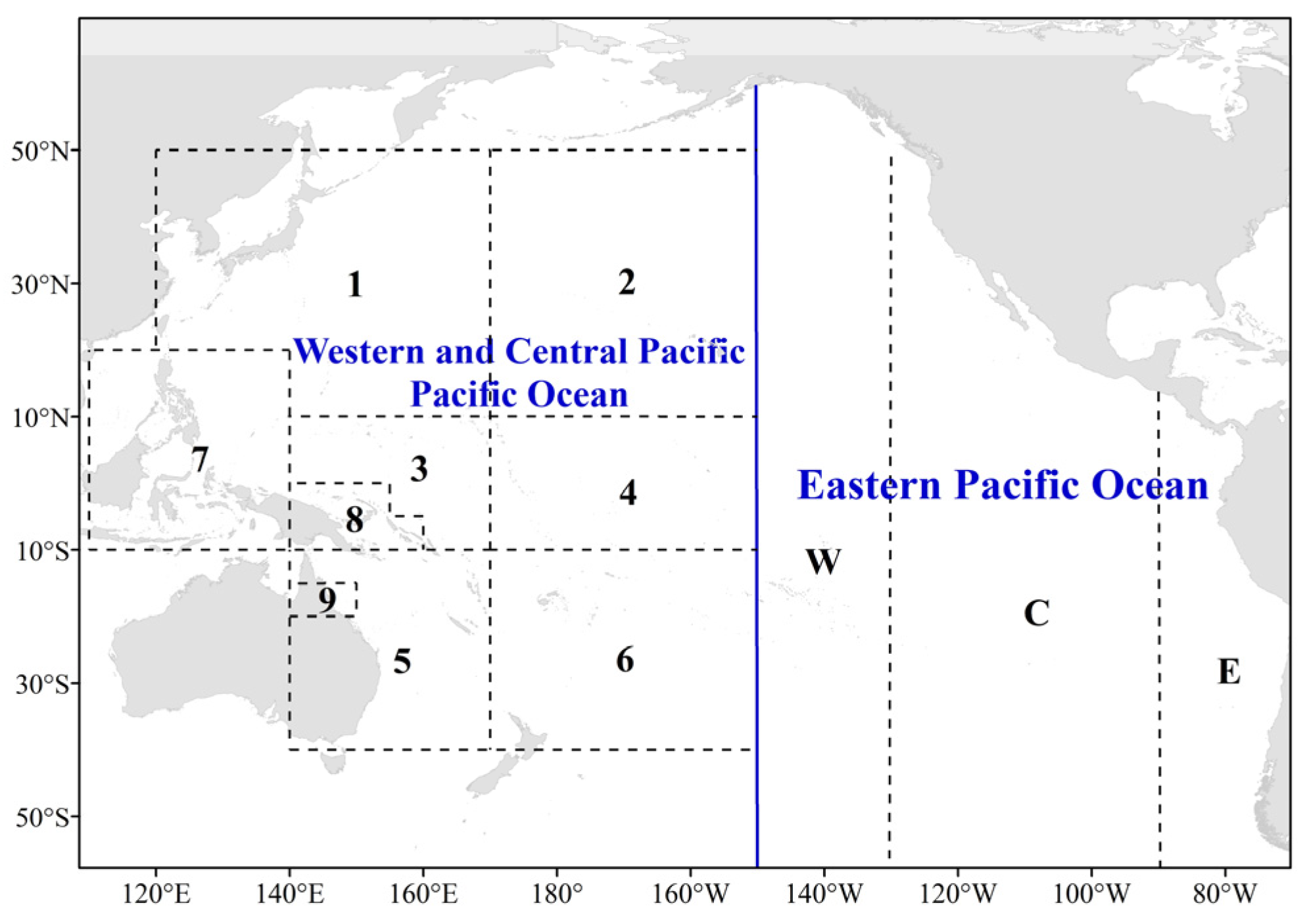
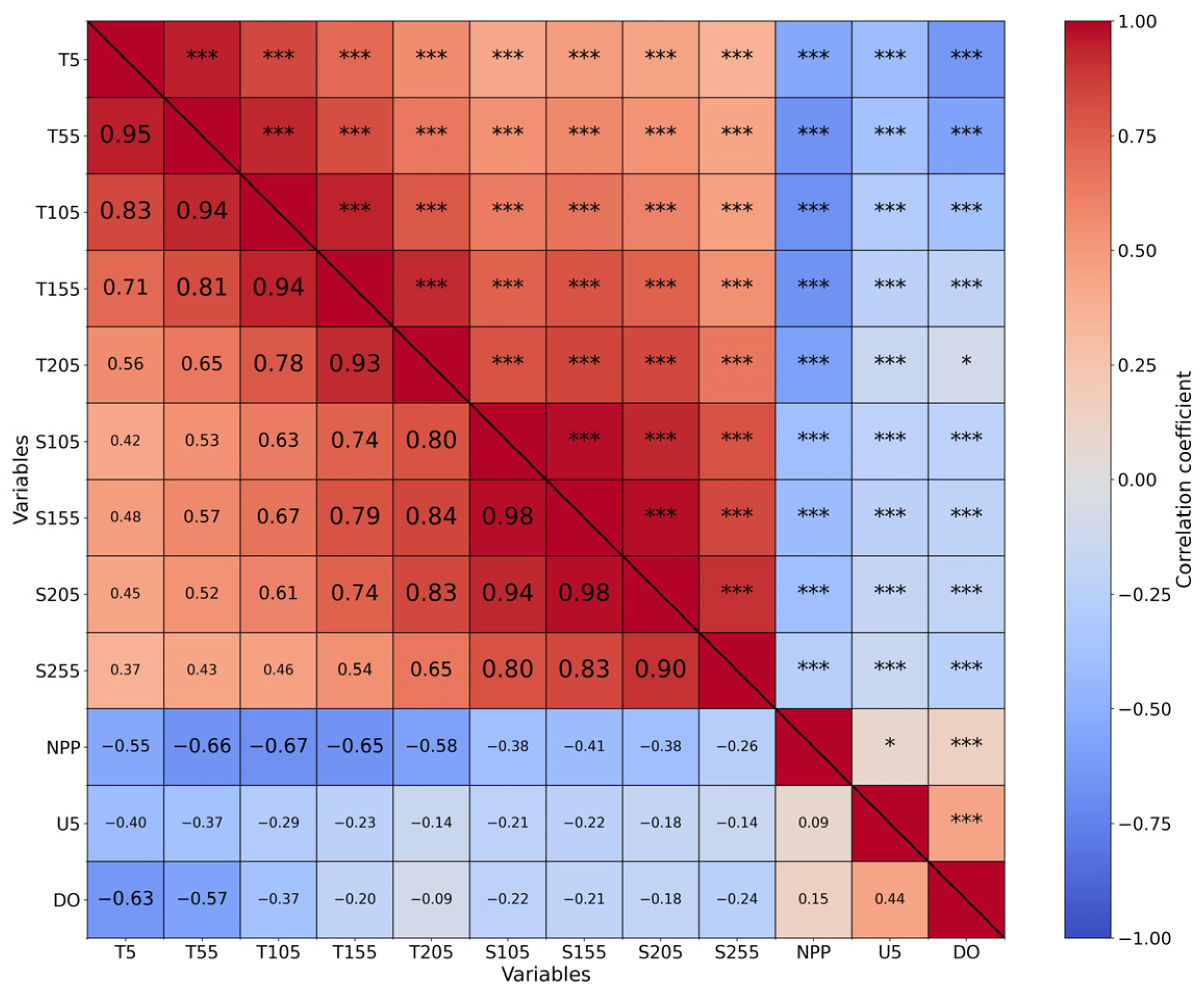

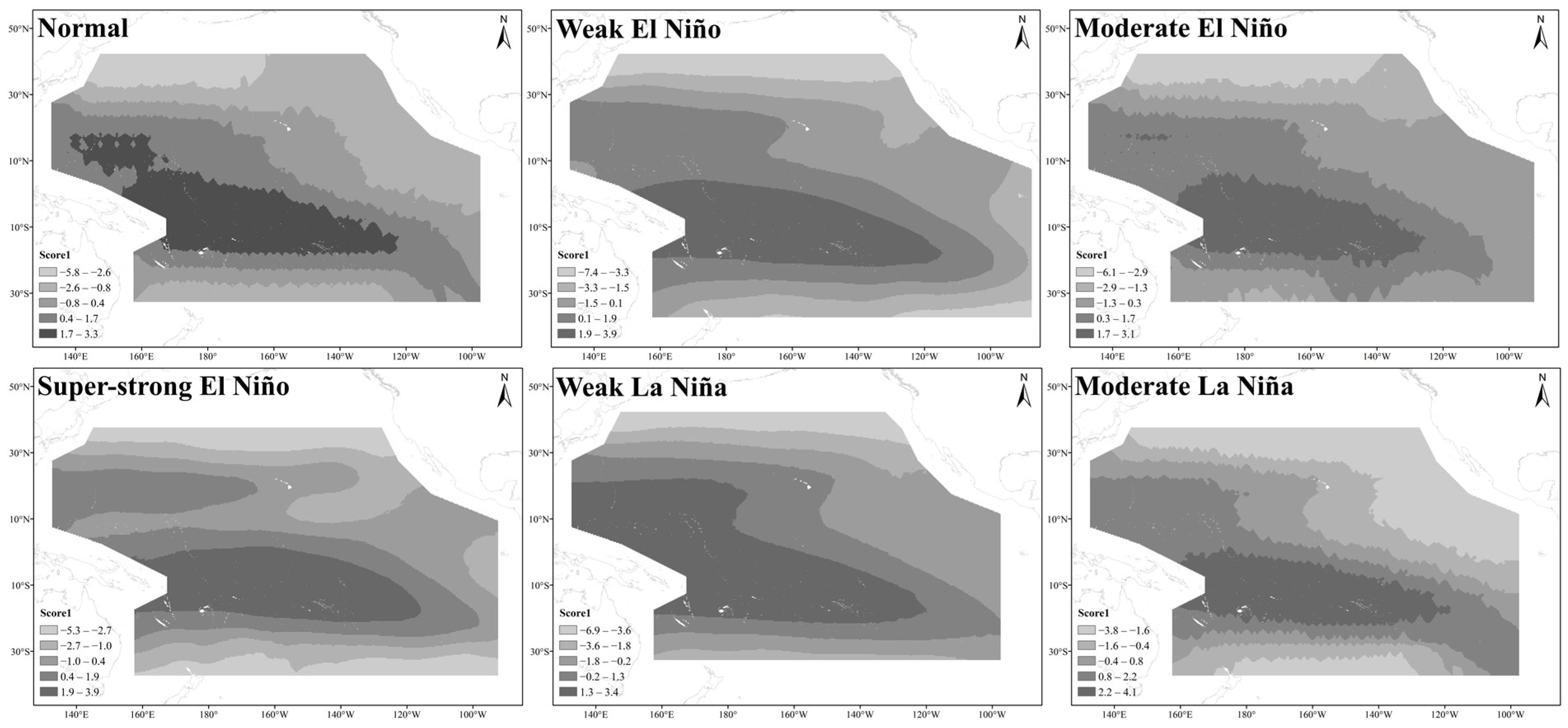
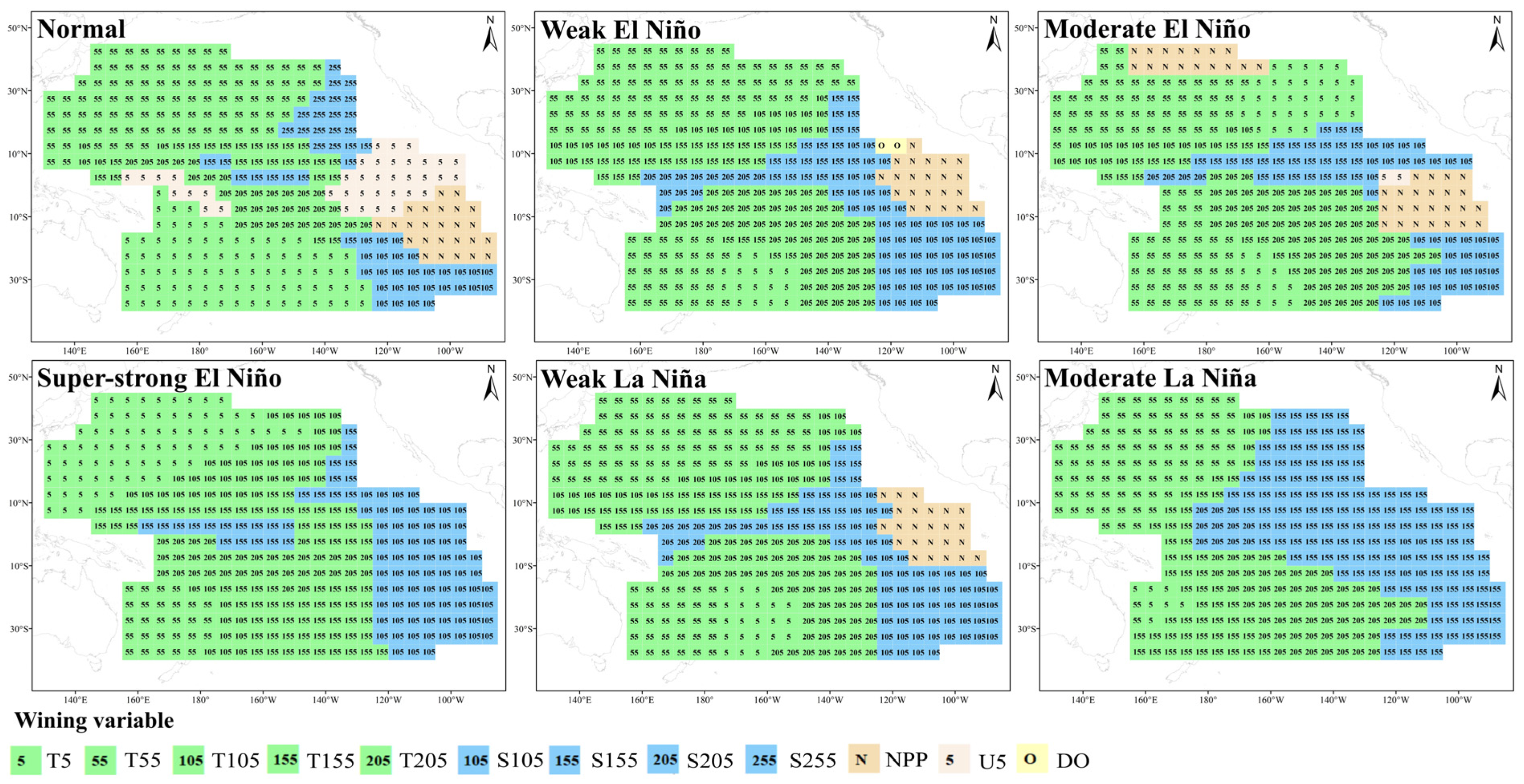
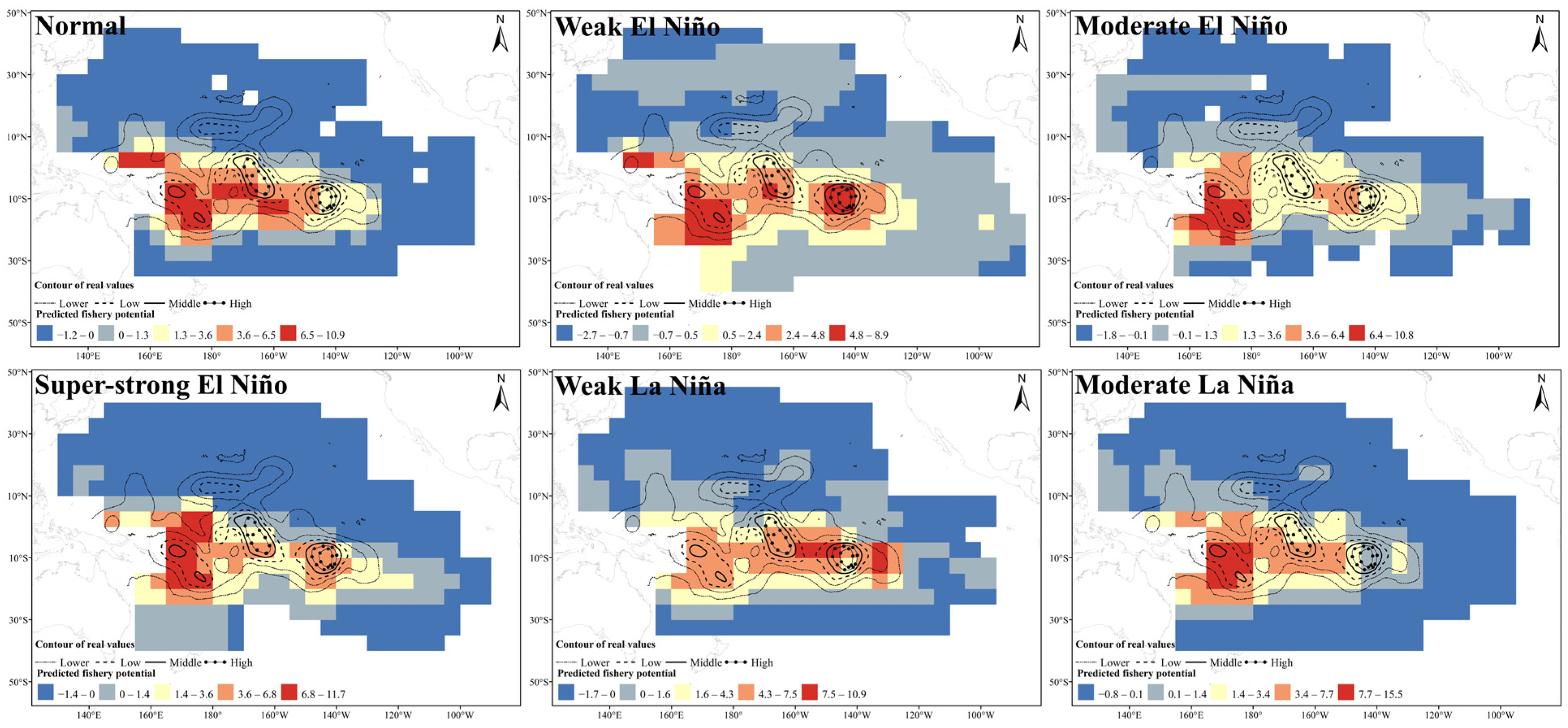
| Variables | Unit | Source |
|---|---|---|
| Dissolved oxygen concentration (DO) | mg/L | Commentary on the Coupled Model Intercomparison Project Phase 6 https://esgf-node.llnl.gov/search/cmip6/ accessed on 1 March 2023 |
| Mixed layer depth (MLD) | m | Oregon State University Data Center http://www.science.oregonstate.edu/ accessed on 1 March 2023 |
| Net primary productivity (NPP) | Mg/m2/day | |
| Sea level anomaly (SLA) | m | Copernicus Marine Environment Monitoring Service http://marine.copernicus.eu/ accessed on 1 March 2023 |
| Temperature of Sea at Various Depths (T5, T55, T105, T155, T205, T255) | °C | NOAA/NWS Space Weather Prediction Center https://cfs.ncep.noaa.gov/ accessed on 1 March 2023 |
| Salinity of Sea at Various Depths (S5, S55, S105, S155, S205, S255) | PSU | |
| Sea water velocity (U5, U55, U105, V5, V55, V105) | m/s |
| ENSO Event Type | Start and End Time (Year.Month) |
|---|---|
| Moderate El Niño | 2009.10–2010.03 |
| Moderate La Niña | 2010.06–2010.12 |
| Weak La Niña | 2011.09–2011.12 |
| Normal year | 2014.03–2014.09 |
| Super-strong El Niño | 2015.10–2016.03 |
| Weak El Niño | 2018.10–2019.03 |
| Environment Variables | Correlation | p-Value |
|---|---|---|
| T5 | 0.50 | 0.00 |
| T55 | 0.53 | 0.00 |
| T105 | 0.57 | 0.00 |
| T155 | 0.53 | 0.00 |
| T205 | 0.38 | 0.00 |
| T255 | 0.18 | 0.00 |
| S5 | 0.15 | 0.00 |
| S55 | 0.17 | 0.00 |
| S105 | 0.31 | 0.00 |
| S155 | 0.42 | 0.00 |
| S205 | 0.41 | 0.00 |
| S255 | 0.31 | 0.00 |
| NPP | −0.22 | 0.00 |
| MLD | 0.07 | 0.15 |
| SLA | −0.06 | 0.24 |
| DO | −0.24 | 0.00 |
| V5 | −0.13 | 0.00 |
| V55 | 0.14 | 0.00 |
| V105 | 0.17 | 0.00 |
| U5 | −0.20 | 0.00 |
| U55 | −0.14 | 0.00 |
| U105 | −0.03 | 0.49 |
| PC | Total | Percent Variance | Cumulative Variance Percentage |
|---|---|---|---|
| 1 | 7.323 | 61.027 | 61.027 |
| 2 | 1.922 | 16.014 | 77.041 |
| 3 | 1.223 | 10.193 | 87.234 |
| 4 | 0.631 | 5.257 | 92.491 |
| 5 | 0.395 | 3.289 | 95.780 |
| Variables | PC1 | PC2 | PC3 |
|---|---|---|---|
| T5 | 0.755 | −0.547 | 0.024 |
| T55 | 0.857 | −0.460 | 0.116 |
| T105 | 0.900 | −0.257 | 0.244 |
| T155 | 0.928 | −0.001 | 0.266 |
| T205 | 0.892 | 0.239 | 0.207 |
| S105 | 0.859 | 0.388 | −0.195 |
| S155 | 0.897 | 0.378 | −0.165 |
| S205 | 0.869 | 0.434 | −0.194 |
| S255 | 0.741 | 0.420 | −0.338 |
| NPP | −0.637 | 0.197 | −0.535 |
| DO | −0.399 | 0.619 | 0.493 |
| U5 | −0.332 | 0.454 | 0.538 |
| Catch Grades | ENSO Event Types | Surface Sea Temperature | Middle Layer Temperature | Deep Layer Temperature | Middle Layer Salinity | Deep Layer Salinity | Other Factors |
|---|---|---|---|---|---|---|---|
| I (High) | Normal year | 0.26 | 0.03 | 0.45 | 0.03 | - | 0.24 |
| Weak El Niño | 0.12 | 0.28 | 0.44 | - | 0.16 | - | |
| Moderate El Niño | 0.08 | 0.15 | 0.46 | 0.08 | 0.23 | - | |
| Super-strong El Niño | 0.10 | 0.14 | 0.57 | 0.19 | - | - | |
| Weak La Niña | 0.13 | 0.08 | 0.61 | 0.03 | 0.16 | - | |
| Moderate La Niña | 0.18 | 0.31 | 0.22 | 0.18 | 0.11 | - | |
| II | Normal year | 0.57 | - | 0.25 | 0.14 | - | 0.04 |
| Weak El Niño | 0.17 | 0.31 | 0.29 | 0.09 | 0.11 | 0.03 | |
| Moderate El Niño | 0.41 | 0.05 | 0.36 | 0.14 | 0.05 | - | |
| Super-strong El Niño | 0.05 | 0.33 | 0.43 | 0.19 | - | - | |
| Weak La Niña | 0.13 | 0.30 | 0.30 | 0.13 | 0.13 | - | |
| Moderate La Niña | 0.42 | 0.19 | 0.12 | 0.19 | 0.08 | - | |
| III | Normal year | 0.56 | 0.17 | 0.17 | 0.11 | - | - |
| Weak El Niño | 0.37 | 0.24 | 0.24 | 0.10 | 0.05 | - | |
| Moderate El Niño | 0.21 | 0.21 | 0.54 | 0.04 | - | - | |
| Super-strong El Niño | 0.40 | 0.36 | 0.12 | 0.12 | - | - | |
| Weak La Niña | 0.30 | 0.30 | 0.15 | 0.21 | 0.03 | - | |
| Moderate La Niña | 0.50 | 0.08 | 0.12 | 0.27 | 0.04 | - | |
| IV | Normal year | 0.50 | 0.29 | 0.04 | 0.14 | - | 0.04 |
| Weak El Niño | 0.36 | 0.19 | 0.02 | 0.23 | - | 0.19 | |
| Moderate El Niño | 0.50 | 0.03 | 0.32 | 0.12 | - | 0.03 | |
| Super-strong El Niño | 0.31 | 0.31 | 0.14 | 0.25 | - | - | |
| Weak La Niña | 0.50 | 0.28 | 0.08 | 0.14 | - | - | |
| Moderate La Niña | 0.16 | 0.16 | 0.12 | 0.52 | 0.04 | - | |
| V (Low) | Normal year | 0.55 | 0.08 | 0.02 | 0.05 | 0.07 | 0.22 |
| Weak El Niño | 0.40 | 0.09 | 0.13 | 0.29 | 0.01 | 0.08 | |
| Moderate El Niño | 0.44 | 0.12 | 0.12 | 0.14 | - | 0.17 | |
| Super-strong El Niño | 0.31 | 0.37 | 0.02 | 0.31 | - | - | |
| Weak La Niña | 0.47 | 0.12 | 0.09 | 0.22 | 0.01 | 0.10 | |
| Moderate La Niña | 0.22 | 0.14 | 0.21 | 0.41 | 0.01 | - |
Disclaimer/Publisher’s Note: The statements, opinions and data contained in all publications are solely those of the individual author(s) and contributor(s) and not of MDPI and/or the editor(s). MDPI and/or the editor(s) disclaim responsibility for any injury to people or property resulting from any ideas, methods, instructions or products referred to in the content. |
© 2024 by the authors. Licensee MDPI, Basel, Switzerland. This article is an open access article distributed under the terms and conditions of the Creative Commons Attribution (CC BY) license (https://creativecommons.org/licenses/by/4.0/).
Share and Cite
Li, M.; Yang, X.; Wang, Y.; Wang, Y.; Zhu, J. The Use of the GWPCA-MGWR Model for Studying Spatial Relationships between Environmental Variables and Longline Catches of Yellowfin Tunas. J. Mar. Sci. Eng. 2024, 12, 1002. https://doi.org/10.3390/jmse12061002
Li M, Yang X, Wang Y, Wang Y, Zhu J. The Use of the GWPCA-MGWR Model for Studying Spatial Relationships between Environmental Variables and Longline Catches of Yellowfin Tunas. Journal of Marine Science and Engineering. 2024; 12(6):1002. https://doi.org/10.3390/jmse12061002
Chicago/Turabian StyleLi, Menghao, Xiaoming Yang, Yue Wang, Yuhan Wang, and Jiangfeng Zhu. 2024. "The Use of the GWPCA-MGWR Model for Studying Spatial Relationships between Environmental Variables and Longline Catches of Yellowfin Tunas" Journal of Marine Science and Engineering 12, no. 6: 1002. https://doi.org/10.3390/jmse12061002
APA StyleLi, M., Yang, X., Wang, Y., Wang, Y., & Zhu, J. (2024). The Use of the GWPCA-MGWR Model for Studying Spatial Relationships between Environmental Variables and Longline Catches of Yellowfin Tunas. Journal of Marine Science and Engineering, 12(6), 1002. https://doi.org/10.3390/jmse12061002





